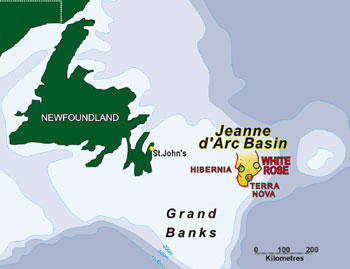 |
In January of this year, the White Rose partners filed a Development Application (DA) to bring this oil field into production. The process for reviewing this DA involves public consultations, an environmental assessment, review by the Canada-Newfoundland Offshore Petroleum Board, and finally federal and provincial government approval. White Rose’s owners are hoping for project sanction by year end and first oil during 2004. The two partners in the White Rose development are Husky Oil Operations Limited (72.5% interest) and Petro-Canada (27.5% interest).
Location and Reservoir
White Rose is located about 350 km east of Newfoundland on the eastern edge of the Jeanne d’Arc Basin and is about 50 km from both Terra Nova and Hibernia. The DA is based on the recovery of an estimated 230 million barrels of oil from the Southern Avalon portion of the field over a production life of 14 years. The potential exists to extend the life of the field through the recovery of other oil pools located in the North and West Avalon areas of White Rose—Husky Oil estimates a further 75-119 million barrels of recoverable oil may exist in these areas. Future testing will be required to prove whether these additional resources are economically viable.
|
| |
| |
 |
|
|
 |
Photo: Gerald Crane/Courtesy of Husky Oil Operations Ltd.
Ongoing White Rose work at Husky’s offices in St. John’s |
| |
White Rose also has considerable quantities of natural gas. Husky Oil
estimates that the field has potential reserves of 2.5 trillion cubic feet.
However, the Company has stated that initially gas production from the
South Avalon White Rose pool will be re-injected for conservation into the North White Rose structure. Furthermore, the White Rose partners have indicated that substantial additional gas resources need to be proven before gas development can occur.
Proposed Development Concept
The White Rose partners intend to develop the field using a floating production, storage and offloading system (FPSO) and subsea well-head structures located in “glory holes”. This system is similar to the one used for Terra Nova. The facility will be able to store between 700,000 and 850,000 barrels of oil, representing approximately 8 to 10 days of production. The total cost of the project over its life is estimated at $3.64 billion (2000 constant dollars). About 68% of these costs are capital expenditures.
Between 18 to 25 wells will be drilled—these will include oil producers as well as water and gas injectors. Enough wells (about 10) will be pre-drilled before first oil in 2004 to be able to produce at capacity. This strategy is similar to Terra Nova’s and essentially means that the facility will be able to reach maximum production relatively quickly. Semi-submersible drilling units will be used to drill the wells. |
| |
| White Rose section continued on next page. |
| |
| Map: Husky Oil Operations Ltd. |
|